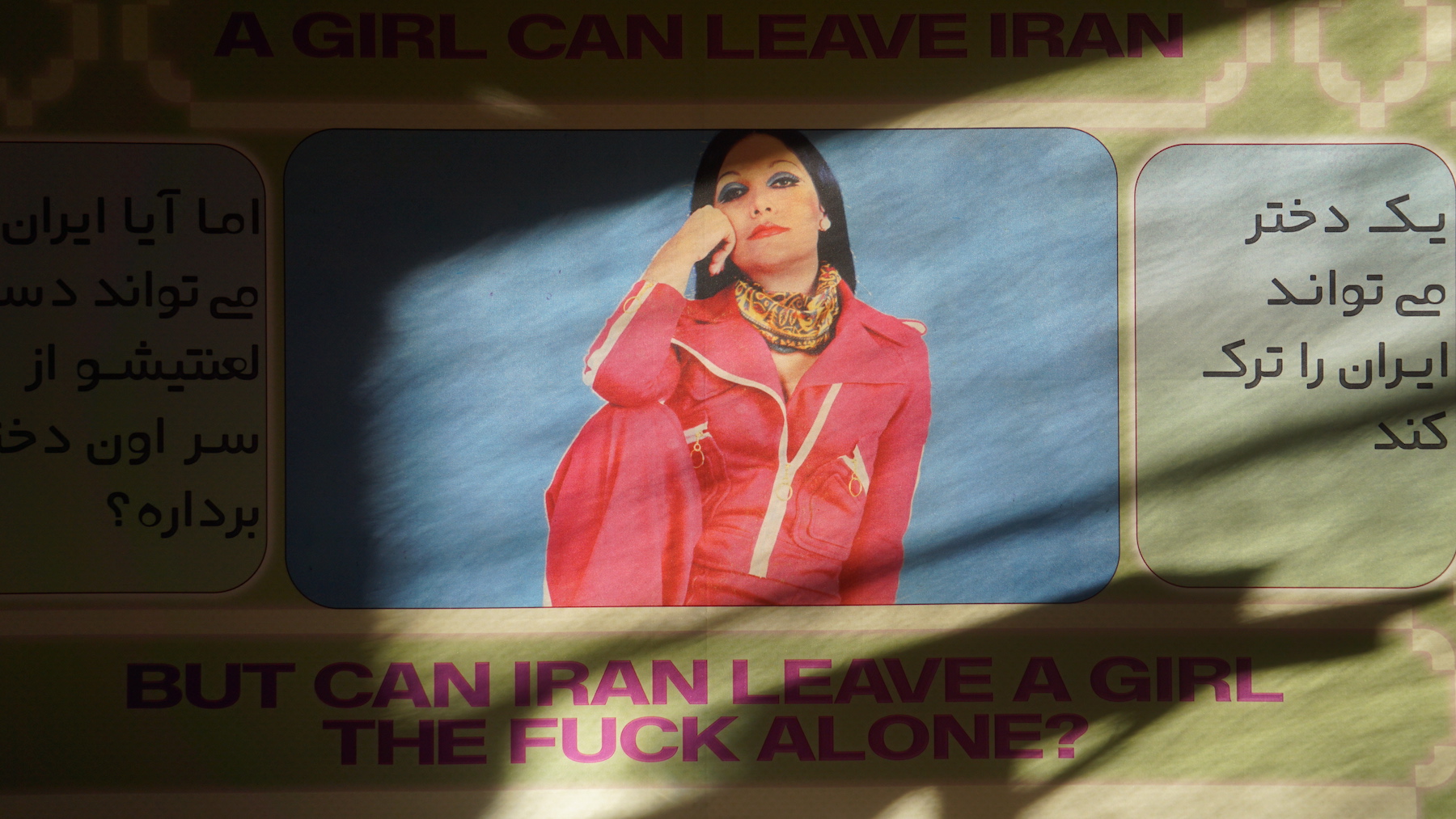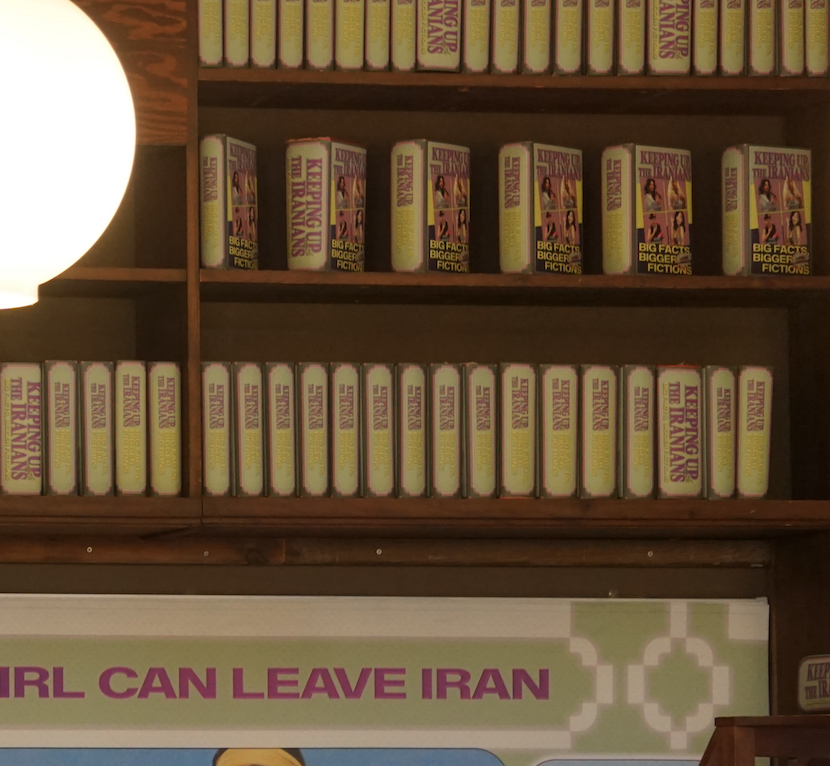Afrang Nordlöf Malekian

A girl can leave Iran but can Iran leave a girl the fuck alone? (2023) in The Bonnier Room in the SSE library. Photo: Lingzi Tang
Afrang Nordlöf Malekian (b. 1995, Iran/Sweden) lives and works in Stockholm. His practice deals with history’s hidden actors and makers, where historicity is put into use as a form of documentation and aspiration that calls for improbable futurities, examining how narratives, hierarchies, systems, and language disappear, re-appear and return, and transform in the most unexpected ways. It poses the question of how to think about the political expression contained in fleeting moments or mundane actions, which are often dismissed as apolitical.
Nordlöf Malekian has previously conducted artistic research at the Arab Image Foundation, Beirut, and been a resident at Cité Internationale des Arts, Paris. He holds an MA from the Dutch Art Institute and an MFA from the Royal Institute of Art in Stockholm. His work has been shown at the 10th Berlin Biennale, Moderna Museet, Tensta Konsthall, and IASPIS.
Nordlöf Malekian’s work is in public collections, including Moderna Museet, Public Art Agency Sweden, and Arab Image Foundation Library.
Exhibited works:
Keeping up with the Iranians (2022)
Digital video, sound
45:13 min
Shortly after the Iranian Revolution of 1979, the new leader, Ayatollah Ruhollah Khomeini, banned music in Iran, equating it to opium. Consequently, many artists relocated to Los Angeles pursuing their artistry in exile. Artists needed to find new ways to make a living, which was possible through recordings or concerts of the dambuli dimbol genre, because that's what people wanted to dance to at parties at mehmooni (a social gathering by invitation to someone’s home, e.g., dinner, dance party, celebration, etc.). A musicalculture of escapism, dance, and joy, which has long been discredited by intellectuals, Marxists, Islamists, and Westerners as apolitical and poisoned art. However, through illegal sound distribution, this music found its way back to Iran and resurfaced in the domestic sphere as mainstream culture. Repression has made this music the signifier of secret collectivity and freedom—a catalyst for realizing dreams.
The performance Keeping Up with the Iranians emerges from music history by reconstructing a mehmooni starring world-famous singers Setareh and Poupak, number one charting pianist Fereshteh, and renowned choreographer Dancing Dina, visiting all the way from Los Angeles, California. At the first performance at Galleri Mejan in Stockholm, three handheld video cameras were handed out to the audience, who could film as they pleased. Their recordings are now on display so you, too, can become a dancer—an angel, if you will.

Big Facts, Bigger Fictions (2023)
Installation, giclée, text
Various dimensions
Books at the Stockholm School of Economics library are camouflaged with the iconic book cover Keeping up with the Iranians: Big Facts, Bigger Fictions. Departing from the performance Keeping up with the Iranians, the cover depicts the four fictional divas in all their glory. Inspired by celebrities aotubiographies, the installation also alludes to the rugged terrain between reality and fiction of our times.
Keeping up with the Iranians: Big Facts, Bigger Fictions, also poses the following questions: what stories do we bear with us? How do we narrate our lives? Pointing to the fact that we live in an increasingly absurd time where life sometimes feels like a book of fiction. In this way, Keeping up with the Iranians: Big Facts, Bigger Fictions riffs on the strings of joy and enthusiasm while giving a playful introduction to the theoretical and historical framework of the performance.
A girl can leave Iran but can Iran leave a girl the fuck alone? (2023)
Giclée, 636 x 119 cm (pic on top of page)
As simple as it is, this work depicts the singer Giti from her two vinyl album covers Yeh del daram (I Have a Heart) and Beh man nakhand (Don’t Laugh at Me) from 1969, as well as Googosh from the vinyl cover of Jomjomak Barge Khazoon (The Shaky-Shaky of the Autumn Leaves) from 1970, collected and documented by artist Afrang Nordlöf Malekian and writer and researcher Nour Helou.
Giti and Googoosh, like many other artists, had to leave Iran after the revolution in 1979. Googoosh stayed in Iran and was sentenced to silence until she left the country in 2000. The ban from practicing her artistry became the voice of absent singing females in the Iranian public sphere. On a broader scale, this silence translated into a metaphor for the oppression of the people in Iran. Until the present day, this ban on female singing in public spaces remains. The question addressed in this work is taken from Afrang Nordlöf Malekian’s Master’s thesis, Keeping up with the Iranians (The Dutch Art Institute, 2022), on Iranian music production in Los Angeles. He follows the fictive artist Setareh, who faces this very issue in her search for success in Dubai and Los Angeles.
Special thanks from the artist to: Ebaluna Guevara Acevedo, Nour Helou, Edwin Safari, Theresa Traore Dahlberg, Cristian Quinteros Soto